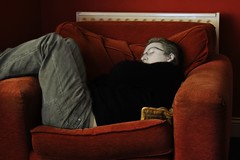
Did you know that what you do when you aren’t moving will affect how you move later on? Our body responds to the stresses placed on it everyday and adapts. The sustained positions we put ourselves in may contribute to certain inflexibilities and a loss in joint range of motion. Inflexibility and a loss of joint range of motion eventually impairs how we move and our ability to do certain tasks as well as we could. There are several times when we may be in one position for a long time: sitting, standing, sleeping, lounging… and muscles and joints will adaptively shorten and stiffen based on these positions. Think about the times during the day when you are in one position for a long time. For many of us it may be sitting due to increased use of the computer for work and life. If you work in a profession that requires lots of sitting, you probably have tight hamstrings, pecs, biceps, and hip flexors. It is important to stretch these muscles out and move out of this seated position frequently during the day to avoid adaptive shortening and stiffening. If this occurs, it creates an imbalance in the musculoskeletal system and this in turn will negatively affect the way in which the body moves. One colleague uses the example of a tent. When you are driving the spikes to hold a tent in place it is important to keep equal tension on all ropes so the tent is centered. If your sustained positions cause inflexibilities and stiffnesses, your tent will be lop-sided with more tension in one rope than the other and if these inflexibilities are severe enough, you may not even be able to drive the spikes into the ground on one side. To continue with the sitting example… if you have tight hip flexors (hip crease muscles) because you sit a lot and they never get stretched, this imbalance causes the lumbar spine to arch, or develop a “sway back,” which places you at greater risk for arthritis of the spine. This tightness can cause abdominal weakness. Weak abdominals do not support the spine as well as they should, and it could get harder to get in and out of bed. If a muscle is weak, it doesn’t perform its job optimally and your function will suffer over time. For your body to move optimally, it has to remain balanced, with all tent ropes pulling and working equally. Here is a self-check to assess your frequented positions and possible imbalances.
Sustained Positions Self-Check
- During the course of a day, try to be consciously aware of the positions you put yourself in- start from the bottom up: feet, knees, hips, back, shoulders, neck. Are you forward, backward, bent in any certain position for a prolonged period?
- Make a note of your preferred and comfortable postures. Do you tend to slouch? Does your back round? Do you jut your head forward? Is your head turned one way or the other?
- When you are seated do you always cross one leg? Do you feel weight on one buttock versus the other? Do you prefer to prop yourself up on one elbow versus the other?
- Do you have a preferred sleeping position? Do you always lie on one side? Are your back and legs rotated? If you sleep on your belly (not a good sleeping position and not recommended by me) do you always have your head turned left or right?
- When you have to stand for a long time in one spot where do you place your weight? Are you more on one leg versus the other? Do you put more pressure on the balls or heels of your feet? Are your feet rolled inwards or outwards?
If you find certain asymmetries, for instance you always sleep on your right side or when you stand you feel most of your weight on your heels, try to correct them. The goal here is to keep the body balanced. If you always sleep on your right side, try to sleep on your left side sometimes. If you feel more than 50% of your weight on your heels, try to shift your weight on your feet so you feel equal weight between the balls of your feet and the heels. Our bodies have subtle preferences such as these that over time can lead to musculoskeletal problems. If you can catch them now and do something about them, you may be able to prevent a painful condition down the line.










March 15, 2010
General Information, Orthopaedic, Prevention